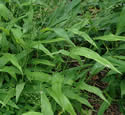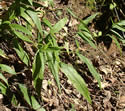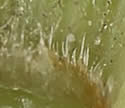Dichanthelium latifolium (Broad-leaved Panic Grass)
| Also known as: | Broad-leaved Rosette Grass |
|---|---|
| Genus: | Dichanthelium |
| Family: | Poaceae (Grass) |
| Life cycle: | perennial |
| Origin: | native |
| Habitat: | part shade; moist to dry; rich woods, wooded banks, thickets |
| Fruiting season: | June - September |
| Plant height: | 18 to 42 inches |
| Wetland Indicator Status: | GP: FACU MW: FACU NCNE: FACU |
| MN county distribution (click map to enlarge): |  |
| National distribution (click map to enlarge): |  |
Pick an image for a larger view. See the glossary for icon descriptions.
Detailed Information
Flower: 

![[photo of panicle]](/udata/r9ndp23q/pd3/dichanthelium-latifolium-061816-14-t.jpg) Erect branching cluster 2¾ to 6 inches long at the top of the stem, the branches strongly ascending with a few to several spikelets (flower clusters) per branch. Spikelets are 2.9 to 3.9 mm (to ~1/6 inch) long, broadest at or just above the middle, green at flowering time, and have 2 florets but appear single-flowered. In summer to fall, somewhat smaller secondary panicles form on the mid-stem branches and may be at least partially hidden in the sheaths.
Erect branching cluster 2¾ to 6 inches long at the top of the stem, the branches strongly ascending with a few to several spikelets (flower clusters) per branch. Spikelets are 2.9 to 3.9 mm (to ~1/6 inch) long, broadest at or just above the middle, green at flowering time, and have 2 florets but appear single-flowered. In summer to fall, somewhat smaller secondary panicles form on the mid-stem branches and may be at least partially hidden in the sheaths.
![[close-up of panicle branch]](/udata/r9ndp23q/pd3/dichanthelium-latifolium-15-13-t.jpg) At the base of a spikelet is a pair of bracts (glumes), the lower glume 1/3 to ½ as long as the spikelet, pointed at the tip and 3-veined, the upper glume as long as the spikelet, 9-veined, short-hairy, blunt to pointed at the tip, sometimes reddish at the base and/or tip. Surrounding a floret is a pair of bracts (lemma and palea), the lower lemma like the upper glume and sterile; the lower palea is obscure or absent. The upper lemma is fertile, about as long as or slightly longer than the upper glume, shiny and hardened, pointed at the tip, the edges rolled around the edges of the similar palea.
At the base of a spikelet is a pair of bracts (glumes), the lower glume 1/3 to ½ as long as the spikelet, pointed at the tip and 3-veined, the upper glume as long as the spikelet, 9-veined, short-hairy, blunt to pointed at the tip, sometimes reddish at the base and/or tip. Surrounding a floret is a pair of bracts (lemma and palea), the lower lemma like the upper glume and sterile; the lower palea is obscure or absent. The upper lemma is fertile, about as long as or slightly longer than the upper glume, shiny and hardened, pointed at the tip, the edges rolled around the edges of the similar palea.
Leaves and stems: 


![[photo of leaves]](/udata/r9ndp23q/pd3/dichanthelium-latifolium-062319-7-t.jpg) The 4 to 6 stem leaves are alternate, ascending to spreading, to 7 inches long, 15 to 40 mm (~½ to 1½ inches) wide, flat, tapering to a pointed tip, heart-shaped and clasping at the base, mostly hairless on both surfaces, sometimes sparsely short-hairy, often with sparse long hairs along the edge near the base, the longer hairs with enlarged pimple-like bases (papillose). In fall, a loose rosette of basal leaves is formed, the leaves much smaller than the stem leaves.
The 4 to 6 stem leaves are alternate, ascending to spreading, to 7 inches long, 15 to 40 mm (~½ to 1½ inches) wide, flat, tapering to a pointed tip, heart-shaped and clasping at the base, mostly hairless on both surfaces, sometimes sparsely short-hairy, often with sparse long hairs along the edge near the base, the longer hairs with enlarged pimple-like bases (papillose). In fall, a loose rosette of basal leaves is formed, the leaves much smaller than the stem leaves.
![[photo of sheaths and node]](/udata/r9ndp23q/pd3/dichanthelium-latifolium-7116-s5-t.jpg) Sheaths are hairless to short-hairy and may have a sparse fringe of longer hairs along the edge. The ligule (membrane where the leaf joins the sheath) is a fringe of hairs .4 to .7 mm long, with dense, fine hairs on the outer edge between the blade and sheath (collar). Nodes are mostly hairless, occasionally sparsely hairy on the lower nodes. Stems are mostly hairless, sometimes sparsely short-hairy, erect to ascending, a few to several from the base forming small clumps. In summer to fall, stems become more spreading and branch from the mid-stem nodes, the branches erect to ascending and not rebranching much.
Sheaths are hairless to short-hairy and may have a sparse fringe of longer hairs along the edge. The ligule (membrane where the leaf joins the sheath) is a fringe of hairs .4 to .7 mm long, with dense, fine hairs on the outer edge between the blade and sheath (collar). Nodes are mostly hairless, occasionally sparsely hairy on the lower nodes. Stems are mostly hairless, sometimes sparsely short-hairy, erect to ascending, a few to several from the base forming small clumps. In summer to fall, stems become more spreading and branch from the mid-stem nodes, the branches erect to ascending and not rebranching much.
Fruit: 
![[photo of maturing florets]](/udata/r9ndp23q/pd3/dichanthelium-latifolium-7116-s3-t.jpg) The whole spikelet drops away when mature, leaving a naked stem behind. Grains (seeds) are enclosed within the persistent lemma and palea.
The whole spikelet drops away when mature, leaving a naked stem behind. Grains (seeds) are enclosed within the persistent lemma and palea.
Notes:
Dichanthelium, formerly lumped with Panicum, are cool-season grasses with two different bloom periods. The primary bloom is a terminal panicle in spring, the secondary is auxiliary panicles in summer into fall, during which time a rosette of basal leaves may also formed. The two forms can be very different from each other; spring identification is more reliably consistent but this is still a difficult genus.
Dichanthelium latifolium, formerly Panicum latifolium, is an uncommon species typically found in rich woods and on shady banks, rarely in open ground. True to its common name, it has the widest leaves of all the Minnesota Dichanthelium species, up to about 1½ inches wide. It is further distinguished by sheaths usually short-hairy; nodes and stems usually hairless; ligule a short (~.5 mm) fringe of hairs plus fringe on the collar; open panicle with ascending branches; spikelets 2.9 to 3.9 mm long, broadest at or just above the middle, short-hairy, blunt to pointed at the tip, and the lower glume 1/3 to ½ as long as the spikelet. The secondary bloom is from the mid-stem nodes where the panicles are fewer-flowered and may be only partially emerged; stems become more prostrate and basal leaves are much smaller than stem leaves. Hairs lack enlarged, pimple-like bases (not papillose), except for the long hairs along the edge near the base of the leaf blade.
A somewhat similar species is Dichanthelium boreale (Northern Panic Grass), which is usually found in open ground and is overall smaller, with narrower leaves (up to ~½ inch), spikelets only about 2 mm long and the lower glume ¼ to 1/3 as long as the spikelet.
Note that multiple references state the fertile lemma of D. latifolium has a minute fringe of hairs at the tip, but we did not observe this on any of our specimens. We'll see if we can spot this on our garden-grown plants in the future.
Native Plant Nurseries, Restoration and Landscaping Services ↓
More photos
 Broad-leaved Panic Grass plants in June
Broad-leaved Panic Grass plants in June Broad-leaved Panic Grass in July
Broad-leaved Panic Grass in July branch and secondary panicle in summer
branch and secondary panicle in summer garden-grown Broad-leaved Panic Grass
garden-grown Broad-leaved Panic Grass Broad-leaved Panic Grass on a semi-shaded bank
Broad-leaved Panic Grass on a semi-shaded bank scan of upper stem
scan of upper stem close-up of ligule and collar hairs
close-up of ligule and collar hairs
Photos by Peter M. Dziuk taken in Fillmore County and in his garden.
Comments
Have you seen this plant in Minnesota, or have any other comments about it?






